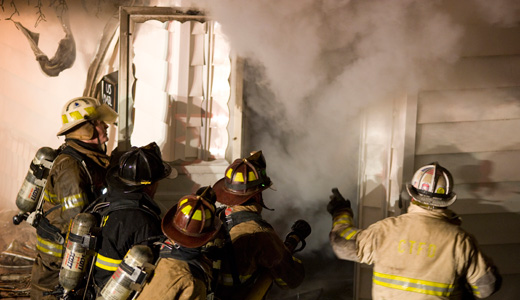
Most of us are dimly aware of toxins in our homes. Maybe we don’t let our infants chew on plastic, or we know not to burn styrofoam in the fireplace. But what if it’s your job to enter buildings full of poisonous smoke, shovel burned debris to prevent fires from reigniting, and sift through toxic ash to determine a fire’s cause? Firefighters do all those things, and they’re seeing increased incidence of cancers as a result.
Last October, researchers from the National Institute for Occupational Safety and Health (NIOSH) published preliminary results from the largest-ever study of cancer in firefighters. Unsurprisingly, they found that firefighters are more likely than the general public to develop respiratory, digestive, and urinary cancers.
“It’s all about the plastics,” says Mark Johnston, president of Fire Fighters Local 452 in Vancouver, Wash. “Fifty or 60 years ago, when a house caught on fire, it was all wood and natural materials. Now it’s all plastic. Think about your house. Your clothes are all synthetic, your carpet is all synthetic, even the wood trim is not wood trim any more.”
When today’s houses burn, the resulting soot, mists, and fumes contain chemicals like benzene, methylene chloride, perchlorethylene, toluene, trichloroethylene, trichlorophenol, and formaldehydes; metals like lead and cadmium; and minerals such as asbestos and crystalline silica. All of those are known human carcinogens.
Firefighters’ protective clothing and respiratory equipment are pretty good, but they’re also exposed after the fire is out, particularly if they remove their breathing apparatus during “overhaul” (when they remove flammable material).
“In a burned-up house, all kinds of toxic gases are being off-gassed,” Johnston said. “When I started in 1983, we didn’t use our breathing apparatus for anything but a fire attack, and when you did your overhaul, you would take that off. We didn’t know the science. But the studies now are showing that a lot of the products of combustion are absorbed through your skin.”
Firefighters can smell smoke on their hair and skin for days after a fire. Chemicals get into skin through the pores.
And those chemicals are causing cancer – at up to twice the rate of the general population, depending on the type of cancer.
NIOSH undertook its multi-year study after the University of Cincinnati conducted a comprehensive analysis of 32 studies of cancer among firefighters. Those studies showed higher rates among firefighters of testicular, prostate, skin, bone marrow, brain, rectum, stomach and colon cancers, and non-Hodgkin’s lymphoma.
Johnston has seen co-workers contract rare cancers like liver cancer, pancreatic cancer, testicular cancer and “lung cancer for guys who’ve never smoked in their life.”
If it’s a firefighters job to protect the public, it’s their union’s job to protect them. The International Association of Fire Fighters (IAFF), Local 452’s parent organization, has pushed state-level legislation around the country and improved safety practices in local fire departments. It’s also developed a cancer registry for union members or their family members to report cancer diagnoses.
At the state legislative level, IAFF wants workers’ compensation agencies to acknowledge that these cancers are work-related, so firefighters can get benefits when they’re diagnosed. The union has been largely successful, with legislation now passed in 33 states, including Washington and Oregon.
In Washington, when a firefighter is diagnosed with brain cancer, malignant melanoma, leukemia, non-Hodgkin’s lymphoma, bladder cancer, ureteral cancer, or kidney cancer, those conditions are considered “presumptively” work-related. Oregon’s list is even longer.
IAFF also considers cancer deaths to be deaths in the line of duty. Local 452 continues to honor two members in that way: Roger Duke, who died of brain cancer in 2009, and Carl Murray, who died of lung cancer in 2013. The local offers an annual scholarship in Duke’s name, and plans to erect a stone memorial to the two at the union hall.
IAFF locals have also called for departments to see that protective gear (known as “turnouts” in firefighter parlance) is decontaminated after a fire.
“When I started, the dirtier your turnouts were, the tougher of a guy you were,” Johnston said. If you left a fire scene without being covered in soot, you were regarded as a shirker. And turnouts were never cleaned.
But when members came to understand that the soot and grime were toxic, Local 452 complained to the Vancouver Fire Department. Initially the department provided cleaning fluid, 55-gallon drums and a brush. Today, it contracts with Northwest Safety Clean to pick up, clean, and return the turnouts.
“We’re trying to change the culture at the fire department,” Johnston says. “We’re not going to accept this old-time old-school mentality any longer. It puts us at risk.”
Don McIntosh is Associate Editor of Northwest Labor Press
Photo: Firefighters attack a smoky fire in Coal Township, Pa., early Monday, March 3. The fire left a couple and their twin 6-year-old daughters homeless. (AP Photo/The News-Item, Larry Deklinski)









